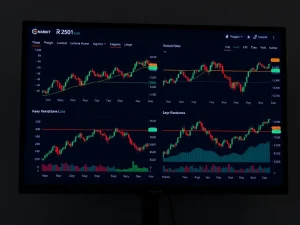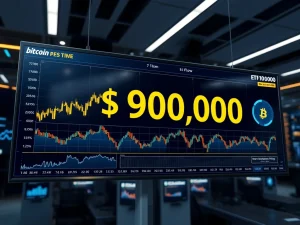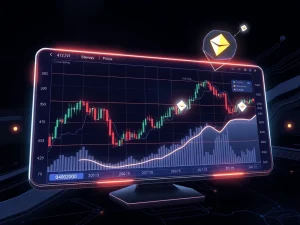Stripe Blockchain Sparks Controversial Crypto Community Reaction

The cryptocurrency world often embraces innovation. However, a recent announcement from payment giant Stripe has ignited a significant crypto community reaction. Stripe’s decision to launch its own Tempo L1 blockchain has divided experts and enthusiasts alike. Many question the necessity of a new Layer-1 network, particularly when existing solutions are already available. This article delves into the core of this debate, examining the arguments for and against Stripe’s ambitious venture into the blockchain space.
Stripe Blockchain: The Rationale Behind Tempo L1
Stripe CEO Patrick Collison announced the new Layer-1 network, Tempo, via an X post. He argued that current blockchains are not optimized for the increasing use of stablecoins and broader crypto applications on Stripe’s platform. Consequently, Collison believes a new infrastructure is essential. He cited the need for high transaction speeds, specifically over 10,000 transactions per second (TPS) at peak. Furthermore, Collison highlighted the issue of transaction fees. Existing blockchains typically denominate fees in native tokens, which he suggests is impractical for real-world financial applications. Therefore, Tempo aims to offer fiat-denominated fees, making it more user-friendly.
The vision for Tempo is clear: to facilitate a range of on-chain financial activities. These include:
- Payment acceptance
- Global payouts
- Remittances
- Microtransactions
- Tokenized deposits
- Agentic payments
Stripe hopes Tempo will simplify these processes, moving them onto a high-scale blockchain infrastructure. This ambitious goal underpins the entire Stripe blockchain initiative.
The Solana TPS Debate and Expert Skepticism
A central point of contention emerged from Collison’s comparison of Tempo’s required TPS with existing networks. He stated that Bitcoin processes around five TPS, Ethereum about 20 TPS, and newer networks like Base and Solana reach approximately 1,000 TPS. This claim regarding **Solana TPS** immediately drew criticism. Mert Mumtaz, CEO of Helius Labs and a prominent Solana advocate, called Collison’s assertion “hilariously wrong on several dimensions.” Mumtaz clarified that 1,000 TPS is “not even close to Solana’s limit.” Data from Solana Explorer, at the time of the original publication, showed Solana processing 3,186 TPS, significantly higher than Collison’s figure. This discrepancy fueled much of the initial **crypto community reaction**, leading many to question the factual basis of Stripe’s justification.
Beyond the Solana TPS dispute, many experts questioned the fundamental need for a new Layer-1. Joe Petrich, head of engineering at NFT platform Courtyard, stated, “No one wants another chain.” He argued that existing solutions already address the problems Collison mentioned for users committed to blockchains. Petrich believes there is no need for yet another chain to “fix” these issues. This sentiment reflects a broader weariness within the crypto space towards an proliferation of new, often redundant, blockchain networks.
Tempo L1 or Ethereum L2? The Layer-2 Alternative
Another significant aspect of the **crypto community reaction** centered on Tempo’s architecture. Many commentators asked why Stripe chose to build a new Layer-1 (Tempo L1) with its own validator set instead of developing a Layer-2 solution on an established network like Ethereum. Devansh Mehta from the Ethereum Foundation posed this question directly. He suggested that outsourcing validator decentralization and diversity to an existing Layer-1 would be more beneficial. Crypto commentator Leo Lanza echoed this sentiment. Lanza questioned, “What prevents Tempo from being built out as an Ethereum L2?”
An Ethereum Layer-2, Lanza argued, could provide several advantages for Stripe. It could still offer custom TPS and fiat-denominated fees. Crucially, it would also leverage Ethereum’s robust network effects, security, interoperability, and potentially lower costs. Building on an existing Layer-1 could allow Stripe to focus on its application layer. It would avoid the complexities and challenges of establishing and securing an entirely new blockchain from scratch. This perspective highlights a common preference within the crypto ecosystem for building upon existing, battle-tested foundations rather than fragmenting the landscape further.
Diverse Views on Stripe’s Stablecoin Payments Vision
While skepticism was prevalent, some prominent figures offered support for Stripe’s **Tempo L1** and its focus on **stablecoin payments**. Steve Milton, CEO of Web3 wallet provider Fintopia, expressed enthusiasm. He called Tempo’s development of “rails for high-scale onchain payments a game-changer.” Milton believes this infrastructure is precisely what apps like Fintopia need. It promises to deliver an even faster, cheaper, and more seamless user experience. Similarly, Max Segal, Chief Operations Officer at Privy, commented that “Tempo looking good here.” These positive reactions suggest that some within the industry see genuine value in Stripe’s approach. They view it as a necessary step for mainstream adoption of crypto payments.
Collison’s emphasis on fiat-denominated fees directly addresses a major hurdle for broader crypto adoption. Many users find the volatility and complexity of native token fees daunting. By denominating fees in fiat, Tempo aims to make **stablecoin payments** feel more familiar and accessible to a wider audience. This user-centric approach could be a significant differentiator. It might appeal to businesses and consumers less familiar with the intricacies of blockchain technology. The debate continues, however, on whether a new Layer-1 is the optimal path to achieve this vision.
The Future of the Stripe Blockchain and Crypto Adoption
The introduction of the **Stripe blockchain** via Tempo L1 has undeniably sparked a lively and often critical **crypto community reaction**. The debate encompasses fundamental questions about blockchain architecture, scalability claims, and the most effective path to widespread adoption of digital payments. While Stripe envisions Tempo as a crucial step towards high-scale, user-friendly **stablecoin payments**, many in the community advocate for leveraging existing Layer-1 security and network effects through Layer-2 solutions. The controversy surrounding Collison’s **Solana TPS** claims further illustrates the technical scrutiny new blockchain projects face.
Ultimately, Tempo’s success will depend on its ability to deliver on its promises of speed, cost-effectiveness, and user experience. It must also overcome the significant challenge of gaining broader industry acceptance and demonstrating a clear advantage over established alternatives. The ongoing discussion highlights the dynamic and evolving nature of the blockchain space, where innovation constantly meets rigorous debate and evaluation from a highly engaged community.









